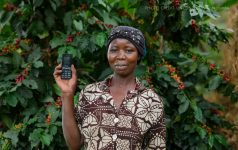Dalberg uses cookies and related technologies to improve the way the site functions. A cookie is a text file that is stored on your device. We use these text files for functionality such as to analyze our traffic or to personalize content. You can easily control how we use cookies on your device by adjusting the settings below, and you may also change those settings at any time by visiting our privacy policy page.
“Development and testing was a crucial learning process for the entire team, seeing how big data can be used for our work. The collaboration with the DDI team, who always provided rapid updates to the dashboard, facilitated this process.” – UNCDF
An estimated 15 percent of the Ugandan population is financially excluded, meaning that they do not have access to formal financial services such as savings, loans, insurance, and mobile money. In rural areas especially, the construction of a digital infrastructure and an increase in mobile money penetration cost-effectively brings hard to-reach populations into the financial system. When people have affordable access to quality financial services, they become more financially resilient because they are provided with the digital and institutional infrastructure to increase and save their income.
Increasing mobile money penetration requires timely insights into the status and trends in mobile money usage patterns. As part of a project supported by the Belgian Government, Dalberg Data Insights has developed an application that leverages mobile phone data to monitor real-time usage and penetration of mobile money services in Uganda. The application is used by the UNCDF MM4P team to better target, implement, and evaluate their programs and initiatives.
UNCDF MM4P’s objective in Uganda is two-fold. First, they seek to increase the amount of people using digital financial products in the country. Second, they are supporting the private sector to test the viability and business case of digital innovations.
Different dashboards track mobile phone penetration, mobile money penetration, mobile money usage, agent coverage, merchant coverage, and mobile money transaction types at very disaggregated geographic levels. UNCDF MM4P can also monitor these indicators for the different value chains they support. By tracking the reach, depth, and impact of the UNCDF MM4P’s financial inclusion interventions across Uganda, the digital and financial inclusion application helps UNCDF MM4P prioritize their interventions, such as where to improve network coverage, and track the impact of bulk payment pilot projects across the country.
“This is an amazing tool for us to have our fingers on the pulse of what’s going on in the field in real time.” -Delia Dean, Digital Finance Expert for UNCDF MM4P
The Results:
Thanks to the application, the UNCDF MM4P team can:
• “prioritize its interventions at country, districts and tower level, with [their] partners. For instance, decisions can be made on where to improve network coverage, why an agent network should be developed in a certain value chain, when and where customer activation or customer education should take place and which new services hold the greatest potential.”
• “track the performance and impact of specific projects in Uganda, mainly on the bulk payment pilots in agro-value chains and for refugees.”
• streamline their data collection strategies across their multilayered, 360° approach.
• capture the evolution of financial behavior across the course of a project cost-effectively and in real time.
What’s Next? Banking Data Integration
Now that agency banking is launched in Uganda,the next step would be to integrate data from banks into the dashboards. This data source integration will be supported by AIDA, a newly launched data platform built by Dalberg Data Insights in partnership with UNCDF. AIDA allows development partners and governments to access valuable data and provides them with the necessary support to transform this data into crucial insights to reach their development goals.







